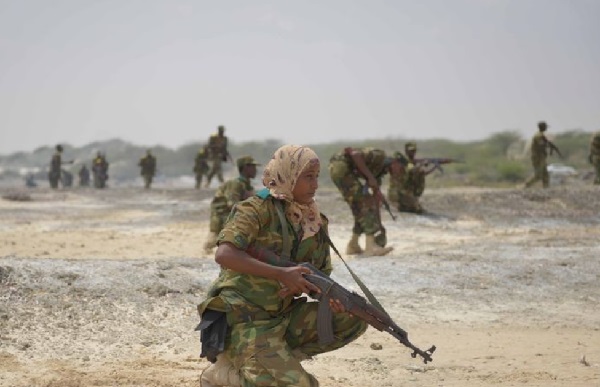
Somalia’s slow military rebuild after decades of civil war is finally yielding results as the country regains control over its security. The development is being watched keenly by both citizens and allies.
SPECIAL REPORT | BIRD AGENCY | African Union-backed forces in Somalia are transferring more military bases to their local counterparts as they gain offensive capabilities to fend off Al-Shabaab militants.
This comes after more than a decade of training and rearming of the Somali National Armed Forces (SNAF) amid relentless attacks by the jihadi group.
The scaling back of operations in the country by the African Union Transition Mission in Somalia (ATMIS) marks a crucial step in empowering the Somali army to combat Al-Shabaab effectively.
The AU notes that while the threats persist, Somali forces are, more than ever, fit for combat after the country’s military made significant strides towards self-sufficiency and operational effectiveness.
Last week, the African Union Transition Mission in Somalia (ATMIS) said in a statement it had handed over the Abdalla Birolle Forward Operating Base (FOB) to the SNAF.
This move marks the fourth transfer in the ongoing Phase Three drawdown of ATMIS forces, a critical step in Somalia’s effort to reclaim its security autonomy.
It is a welcome development for SNAF which has a storied history, dating back to its establishment in 1960, just before Somalia gained independence.
From the early 1960s to 1977, when Somalia enjoyed good relations with the Soviet Union, its Armed Forces boasted the largest armoured and mechanised force in Africa outside of North Africa.
However, they faced substantial challenges following the collapse of the central government in 1991, which plunged the country into decades of civil war.
Despite these adversities, the SNAF has been gradually rebuilding with substantial international support, notably from the African Union and the United Nations.
“Somalia once provided sanctuary to freedom fighters from other African countries during their struggles for independence. It is our duty to reciprocate the support and sacrifices made by the Somali people for our own countries’ freedom,” said Siyuvile Bam, Deputy Special Representative of the Chairperson of the AU Commission for Somalia during the handover of the Abdalla Birolle to Somali forces.
“Although we are handing over security responsibilities, the African Union will not abandon Somalia and will continue supporting a Somali-led peace and security process.”
ATMIS Sector Two Commander Brig. Rashid hailed the collaboration between the ATMIS KDF contingent and Somali Security Forces, which led to successful operations against Al-Shabaab in Jubaland State.
He encouraged the incoming SNA forces to uphold the security improvements and continue the progress made by ATMIS troops.
Al-Shabaab, a militant group with ties to al-Qaeda, has been a significant threat in Somalia since its formation in 2006 and has been responsible for numerous attacks within Somalia and in neighbouring countries, making the strengthening of the SNAF crucial for regional stability.
Miffed by incessant attacks and kidnappings, Kenya deployed about 4,660 soldiers to Somalia in October 2011 to help neutralise Al-Shabaab’s ability to launch attacks within its territory.
The Kenyan Defense Forces (KDF) has played a crucial role in the initial push against Al-Shabaab, securing key areas and providing a buffer for Somalia’s fledgling government.
Over the years, the number of Kenyan troops has gradually been reduced as Somali forces have grown stronger and more capable.
Ergo, the transfer of these bases is a significant milestone for Somalia, once ravaged by decades of civil war, lawlessness, and the persistent threat of Al-Shabaab.
For years, Somali forces relied heavily on the African Union and other international partners for security. The ability to take over and maintain these bases reflects the growing strength and capability of the Somali National Armed Forces.
Located 52 kilometres southwest of the port city of Kismayo, the Abdalla Birolle FOB has been manned by ATMIS KDF since 2016. The base is instrumental in protecting Kismayo International Airport and key supply routes.
This handover is part of the UN Security Council Resolution 2741 (2024), which mandates ATMIS to withdraw 2,000 troops by June 30, 2024, and another 2,000 by September 30, 2024.
While the threat from Al-Shabaab remains, the successful transition of the Abdalla Birolle FOB to Somali control signifies Somalia’s growing capacity to manage its security challenges independently.
The transition boosts the morale of the Somali forces and symbolises progress for the Somali people. But continued international support will still be vital in sustaining the gains made to suppress Al-Shabaab.
As ATMIS scales down its presence, the responsibility for maintaining security increasingly falls on Somali forces with their success or failure having profound implications not only for Somalia but for the stability of the entire Horn of Africa region.
****
SOURCE: Seth Onyango, bird story agency
 The Independent Uganda: You get the Truth we Pay the Price
The Independent Uganda: You get the Truth we Pay the Price



